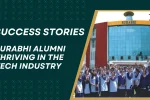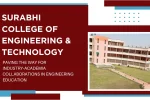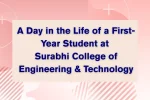Exploring Research Opportunities at Surabhi: Surabhi College of Engineering & Technology stands out as a beacon for undergraduate research in emerging technologies. With trends like artificial intelligence, Internet of Things, robotics, and sustainable energy reshaping our world, students at Surabhi get a rare chance to lead innovation. The institute values applied learning—where theory meets real work through hands‑on experiments, prototype development, and industry‑linked projects.
Surabhi College of Engineering & Technology nurtures a vibrant research ecosystem that encourages students to explore, experiment, and excel. From AI‑driven software to green‑energy prototypes, the college supports interdisciplinary work in data science, automation, and embedded systems. Mentors guide students through idea generation, lab testing, documentation, and publication. This rich, well‑funded environment ensures undergraduates graduate not just with degrees but with practical skills, invention mindsets, and competitive edge in tech careers.
Surabhi College of Engineering & Technology — Where Research Sparks Innovation
Within this inspiring environment, Surabhi College of Engineering & Technology elevates student research by offering access to modern labs, expert faculty, and real‑world collaboration. The college’s Research and Innovation Cell curates projects in artificial intelligence, machine learning, IoT, robotics, renewable energy, and data analytics. Students gain mentorship, funding support, and publication opportunities. Interdisciplinary teams work on real problems—like sensor networks for smart cities or AI models for health care. This approach builds technical depth, design thinking, and entrepreneurial spirit, ensuring graduates are inventive, industry‑ready, and socially aware innovators.
1. Why Research Is Encouraged at Surabhi
Research at Surabhi matters because it:
- Fosters critical thinking and innovation
- Connects academic theory with practical industry uses
- Prepares students for higher studies and R&D careers
- Builds strong portfolios for placements in tech and engineering sectors
- Encourages teamwork and communication skills essential to startups and labs
2. Types of Research Projects at Surabhi
a) AI and Machine Learning Projects
Students design intelligent systems such as voice‑activated assistants, medical image analysis tools, and predictive analytics models. Projects often use Python, TensorFlow, and cloud services to bring AI solutions to life.
b) Internet of Things (IoT)
Surabhi researchers craft IoT devices like smart meters, environmental sensors, and home‑automation kits. Using Arduino, Raspberry Pi, and MQTT, they solve real problems in agriculture, energy, and urban planning.
c) Robotics and Automation
Hands‑on projects include robotic arms, obstacle‑avoiding vehicles, and drone systems. These bring real‑world control‑systems skills to students in mechanical, ECE, and computer science disciplines.
d) Green and Sustainable Tech
Teams explore solar‑powered systems, energy‑efficient lighting, and waste‑water treatment. Projects include smart agriculture using solar panels and sensor feedback to optimize resource use.
e) Data Science and Analytics
Students mine datasets from health, environment, and education to derive trends and decisions using R, Hadoop, and Python data‑science libraries.
3. Research Infrastructure and Labs
Surabhi maintains a well‑equipped ecosystem to support innovation:
- AI & ML Lab: GPUs, high‑performance servers, and cloud access
- IoT Lab: Microcontrollers, wireless modules, sensor kits
- Automation Lab: Robotic arms, PLC trainers, motor controllers
- Data Center: Hadoop cluster, notebook servers, analytics software
- Renewable Energy Lab: Solar panels, wind turbine models, control systems
The Research and Innovation Cell ensures continuous upgrades, seed funding, and lab access for student teams.
4. Collaborations and Funding
The college actively seeks partnerships and funding to scale student ideas:
- Industry partnerships: Tech firms in AI, robotics, and manufacturing provide mentorship and project sponsorship
- Academic MoUs: Ties with national research labs—AICTE, CSIR, MSME—to support innovation
- Startup support: Seed grants and incubation for student‑led startups
- Competitions & Grants: Government initiatives through Make in India and innovation schemes
These connections help take student prototypes from campus to real‑world testing and sometimes to market.
5. Recent Student Research Projects
Smart Farm: AI & IoT
A team built a soil‑moisture monitoring system with solar charging and smartphone alerts to guide irrigation. This won a national eco‑innovation award.
Drowsy‑Driver Detection
An AI model was trained using computer‑vision tools to alert drivers in real time. The team published their paper and presented at an international conference.
Hostel Energy Saver
A campus pilot used IoT sensors and data aggregation to reduce electricity use by 18% over a semester—demonstrating scalable solutions for smart buildings.
6. List of Two Key Research Domains
- Artificial Intelligence and IoT Applications
- Green Energy and Smart Automation
7. Benefits for Students and Faculty
- Real research publications in peer-reviewed journals
- Practical skills in robotics, sensor networks, cloud computing, data analytics, and embedded systems
- Connections with industry mentors, researchers, and influencers
- Support for provisional patents and prototype testing
- Stronger placement records through meaningful R&D experience
8. Role of Mentorship and Innovation Culture
Mentors guide students in research design, lab methods, result documentation, and presentations. The college hosts internal hackathons and innovation fairs that drive a culture of curiosity. Winning ideas receive funding, mentoring, and support for patenting and incubation. This community energy helps students turn raw ideas into viable solutions that impact society and industry.
FAQs
1. How do I join a research project at Surabhi?
Visit the Research and Innovation Cell, submit a proposal or apply to join a faculty-led project. Teams regularly seek members with diverse technical skills.
2. Are projects open to all years of study?
Yes. First- and second-year students assist in ongoing work. Major projects typically involve final-year teams but undergraduates at all stages benefit from early exposure.
3. Can I publish my research?
Absolutely. Surabhi encourages publication in conferences and journals. Faculty mentors help with writing, peer review, and presentation training.
4. Is there funding for student research?
Yes. The college connects students with government grants (e.g., AICTE, MSME), industry sponsorships, and seed funding for prototype development.
5. Does research help in placement?
Definitely. Employers in R&D, tech startups, and engineering firms value hands‑on research, publications, and innovation experience—making students more employable and competitive.
Final Thought & Call to Action
Research at Surabhi College of Engineering & Technology isn’t just extra work—it’s a launchpad for innovation. Students learn by doing, publishing, and problem‑solving. They build solutions in AI, IoT, robotics, and sustainability—leaving college ready to lead.
If you’re a future engineer excited about cutting‑edge tech, now’s the moment. Visit the Research and Innovation Cell, explore current projects, pitch your idea, or partner with us. Join Surabhi’s next wave of inventors shaping the future. Let’s build tomorrow—together.






